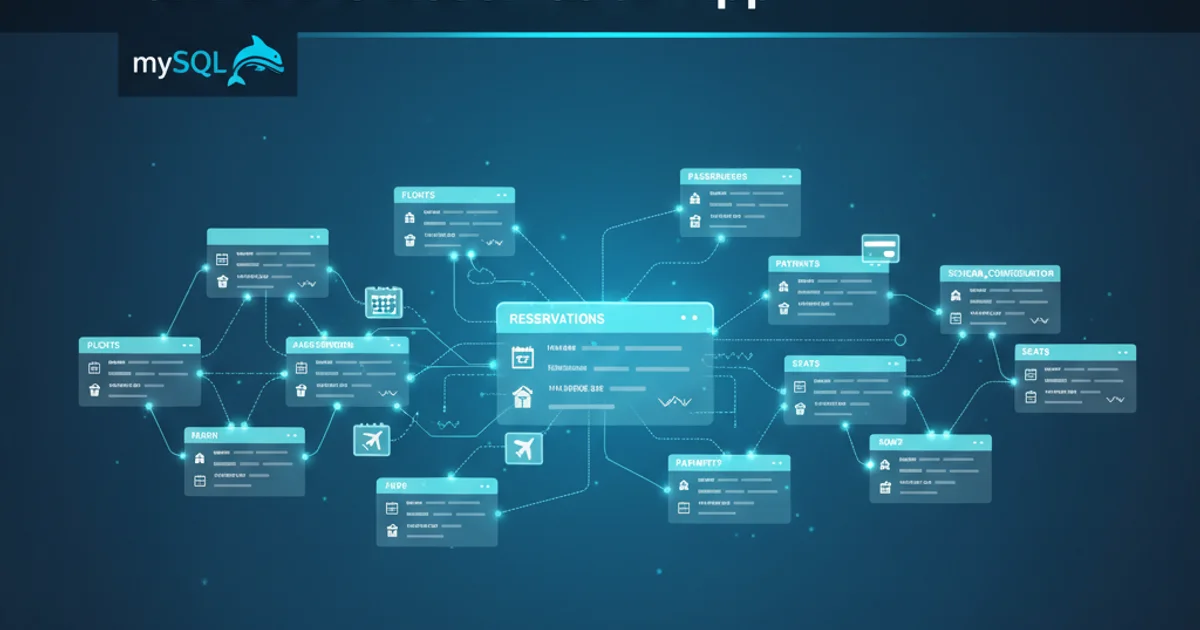Dynamically structured mySQL database for an Airline Reservation App
Designing a Dynamically Structured MySQL Database for an Airline Reservation App

Explore strategies for building a flexible MySQL database schema capable of handling the evolving needs of an airline reservation system, from flight details to passenger bookings.
Developing an airline reservation application requires a robust and flexible database to manage a myriad of data points, including flights, passengers, bookings, and ancillary services. While a rigid schema might seem straightforward initially, the dynamic nature of airline operations—new routes, varying aircraft configurations, promotional offers, and evolving regulatory requirements—demands a more adaptable approach. This article delves into designing a dynamically structured MySQL database that can gracefully accommodate these changes without constant schema migrations.
Core Entities and Relationships
At the heart of any airline reservation system are several key entities. Understanding their relationships is crucial for building a scalable and maintainable database. We'll start with the fundamental tables and then explore how to introduce dynamism.
erDiagram
AIRPORT ||--o{ FLIGHT : "origin/destination"
AIRCRAFT ||--o{ FLIGHT : "used by"
FLIGHT ||--o{ BOOKING : "has"
PASSENGER ||--o{ BOOKING : "makes"
BOOKING ||--o{ TICKET : "generates"
TICKET ||--o{ SEAT : "assigns"
FLIGHT ||--o{ FLIGHT_SEGMENT : "composed of"
FLIGHT_SEGMENT ||--o{ AIRCRAFT_TYPE : "requires"
BOOKING ||--o{ ANCILLARY_SERVICE : "includes"
ANCILLARY_SERVICE ||--o{ SERVICE_TYPE : "is a"
PASSENGER ||--o{ LOYALTY_PROGRAM : "enrolled in"Entity-Relationship Diagram for a basic Airline Reservation System
The ER diagram above illustrates the core entities. However, a 'dynamically structured' database goes beyond these fixed relationships. It implies the ability to add new attributes, services, or even entire data structures without altering the core schema. This is where JSON data types and EAV (Entity-Attribute-Value) models can be particularly useful in MySQL.
Implementing Dynamic Attributes with JSON Columns
MySQL 5.7 and later versions offer a native JSON data type, which is ideal for storing semi-structured data. This allows you to add flexible attributes to entities like FLIGHT, BOOKING, or PASSENGER without adding new columns to the table schema. For instance, a FLIGHT might have dynamic attributes like 'wifi_available', 'meal_options', or 'special_promo_code' that vary per flight or even per segment.
ALTER TABLE Flights
ADD COLUMN dynamic_attributes JSON NULL;
-- Example of inserting data with dynamic attributes
INSERT INTO Flights (flight_number, origin_airport_id, destination_airport_id, departure_time, arrival_time, aircraft_id, dynamic_attributes)
VALUES (
'AA101',
1,
2,
'2023-10-27 08:00:00',
'2023-10-27 11:00:00',
101,
'{"wifi_available": true, "meal_options": ["vegetarian", "vegan"], "promo_code": "FALL23"}'
);
-- Example of querying dynamic attributes
SELECT
flight_number,
JSON_EXTRACT(dynamic_attributes, '$.wifi_available') AS wifi_status,
JSON_UNQUOTE(JSON_EXTRACT(dynamic_attributes, '$.promo_code')) AS promo_code
FROM Flights
WHERE JSON_EXTRACT(dynamic_attributes, '$.wifi_available') = TRUE;
Adding a JSON column and querying dynamic attributes in MySQL.
Managing Dynamic Ancillary Services
Airlines frequently introduce new ancillary services (e.g., extra baggage, lounge access, priority boarding, special meals). Instead of adding a new column for each service to the BOOKING table, a more dynamic approach involves a separate ANCILLARY_SERVICE table linked to BOOKING and a SERVICE_TYPE table to define the available services.
CREATE TABLE ServiceTypes (
service_type_id INT PRIMARY KEY AUTO_INCREMENT,
service_name VARCHAR(100) NOT NULL UNIQUE,
description TEXT,
base_price DECIMAL(10, 2),
is_active BOOLEAN DEFAULT TRUE,
-- Dynamic configuration for the service type
config_json JSON NULL
);
CREATE TABLE AncillaryServices (
ancillary_service_id INT PRIMARY KEY AUTO_INCREMENT,
booking_id INT NOT NULL,
service_type_id INT NOT NULL,
quantity INT DEFAULT 1,
price DECIMAL(10, 2),
-- Specific details for this instance of the service
details_json JSON NULL,
FOREIGN KEY (booking_id) REFERENCES Bookings(booking_id),
FOREIGN KEY (service_type_id) REFERENCES ServiceTypes(service_type_id)
);
-- Example: Adding a new service type and booking it
INSERT INTO ServiceTypes (service_name, description, base_price, config_json)
VALUES (
'Premium Lounge Access',
'Access to exclusive airport lounges before departure.',
50.00,
'{"max_hours": 3, "includes_food": true}'
);
INSERT INTO AncillaryServices (booking_id, service_type_id, quantity, price, details_json)
VALUES (
123,
(SELECT service_type_id FROM ServiceTypes WHERE service_name = 'Premium Lounge Access'),
1,
50.00,
'{"guest_name": "John Doe", "entry_time": "2023-10-27 06:00:00"}'
);
Schema and example for dynamic ancillary services using JSON columns.
ServiceTypes table, and then record instance-specific details in the AncillaryServices table, all without schema changes to the core booking tables.Considerations for Performance and Data Integrity
While dynamic structures offer flexibility, they come with trade-offs. Over-reliance on JSON columns for critical, frequently queried data can lead to performance bottlenecks. For attributes that are consistently present and often used in WHERE clauses or JOIN conditions, traditional normalized columns are usually superior. Data integrity also needs careful consideration; JSON schemas can be enforced at the application layer, but MySQL itself doesn't provide native JSON schema validation.
1. Identify Static vs. Dynamic Data
Categorize your data: core, unchanging attributes should be in normalized columns. Flexible, evolving, or less frequently queried attributes are candidates for JSON columns.
2. Use Generated Columns for Indexing JSON
For frequently queried JSON fields, create a virtual or stored generated column and index it. This allows MySQL to optimize queries on those specific JSON paths.
3. Implement Application-Level Validation
Since MySQL doesn't enforce JSON schema, ensure your application layer validates the structure and content of JSON data before insertion or update to maintain data integrity.
4. Monitor Performance
Regularly monitor query performance, especially for queries involving JSON columns. Optimize indexes and query patterns as needed to prevent performance degradation.